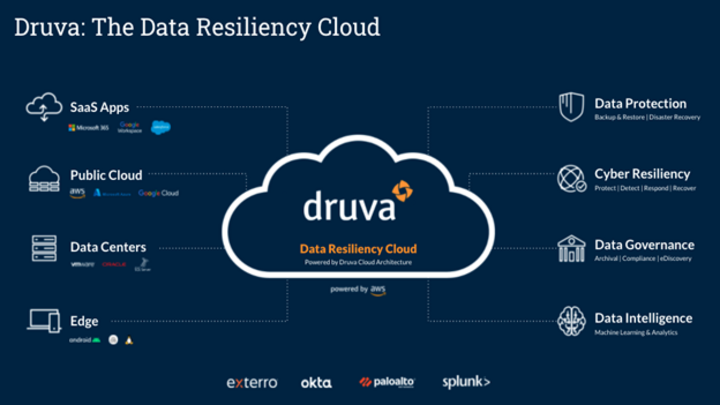
A moment of reckoning: it's time to revolutionise data protection
The data centre is no longer the centre of data
Data has never been more valuable than it is today. But as businesses create, store and analyse increasing volumes of data in more locations, they also struggle to protect and secure it from new threats, such as ransomware. Leading organisations are shifting from passive 'data protection' to active 'data resilience' to ensure that their data and their business is always on. Finally, they are looking to the cloud to enable them to scale with their business needs.
The nature of today's data security challenge
The first challenge is the sheer complexity of modern enterprise data infrastructure. Every organisation is now a digital business. Traditional infrastructure is being moved to the cloud or replaced with SaaS, while new customer-centric applications are being built in the cloud. The pandemic further accelerated cloud transformations, which means more data is being stored in the cloud, SaaS applications and at the edge. The data centre is no longer the centre of data - it is everywhere, which creates more complexity and new risks.
The second challenge is ransomware. Attack volumes have escalated dramatically during 2021, and Gartner predicts at least 75 per cent of organisations will face one or more attacks by 2025. The magnitude of the attacks has also increased: so much so that the average ransom payment jumped to more than $570,000, according to Palo Alto Networks. Additionally, the attacks have evolved, often first targeting backups to remove any chance a victim might have at recovery. We are also seeing an increase in software supply chain attacks, where cyber criminals target software vendors to compromise their product before it is embedded in other software. Businesses are more connected than ever before, forming a digital ecosystem that cyber criminals are exploiting. The question is not whether your environment will be compromised, but how you will respond to the event.
The third challenge is that IT teams are already stretched thin and simply cannot take on more work. There is a global shortage of cyber skills, and enterprises are in need of developers and data scientists who can help them build value, so the additional protection and security challenges must be resolved by fewer people within tighter budgets.
A driving need for data resiliency
Organisations cannot solve all three protection challenges with their existing approach to data protection. They have a siloed data architecture that is inert and fragile. Instead of streamlining, they are adding resources to build and manage multiple tools from a variety of vendors to gain control over their data protection silos. They are likely paying for infrastructure that is underused or completely redundant. It's messy and unpredictable, which makes it even harder to secure. This represents a tipping point for businesses.
Marginal gains aren't cutting it in the digital economy, so organisations need to shift from data protection to data resiliency. Data resiliency eliminates the silos and shifts from passive to active. Instead of creating data copies, data resiliency positions customers to recover. Instead of waiting for an administrator to react to an outage or attack, data resiliency proactively identifies, alerts, and responds to problems in the data infrastructure. Instead of protecting from legacy threats, data resiliency protects against new issues such as ransomware attacks, insider threats, and supply chain attacks. Data resiliency revolutionises data protection.
To achieve data resiliency, a new approach is necessary: one that needs to break down barriers, scale quickly, support multiple clouds and geographies, enhance cyber resilience and compliance, and do so within a transparent and predictable commercial model.
The Druva Data Resiliency Cloud
Druva is solving these complex challenges through a fully autonomous, centralised and cloud-native approach. The Druva Data Resiliency Cloud brings the simplicity, scalability and security of public cloud to enterprise data protection and data management. The Druva Data Resiliency Cloud is an at-scale SaaS solution that advances an organisation's cyber, data and operational resilience, without depending on hardware, software or user management.

The Druva Data Resiliency Cloud is available globally, can be deployed in as little as 20 minutes and spans multiple workloads and use cases. The on-demand scaling of Druva's cloud-native architecture reduces total cost of ownership for customers, while the centralised data control plane enables Druva to leverage analytics, artificial intelligence and machine learning to optimise performance, reduce cost and secure data from ransomware attacks. Additionally, the Druva Data Resiliency Cloud's autonomous protection empowers developers to build and deploy applications faster.
This convergence of management into one centralised interface, no matter where data is located, makes the task of data protection, security and above all resiliency less resource-intensive. For a predictable monthly fee, organisations are free to invest in analysis of their data for insight, discovery and action, knowing that the protection, security and compliance are taken care of by those who specialise in them.
By delivering cyber, data and operational resilience via the Druva Data Resiliency Cloud, organisations are able to transform their data infrastructures from being sources of management burden, risk and cost into autonomous, high performing accelerators of their business.

Stephen Manley is CTO of Druva, where he delivers solutions to help customers extract the full potential of their data. In leading development of data management capabilities for startups and serving as CTO of the Data Protection Group at Dell EMC, Stephen found his passion in partnering with customers to solve data protection challenges for today's enterprise and evolve modern data storage. He also spent time at NetApp as a senior technical director of data protection. Stephen is excited to connect with new customers and technology to transform how people protect, preserve, and use their data. Stephen works tirelessly to bring the latest innovative technologies to our customers, so they can always protect, manage, and increasingly obtain more value from their data.

















